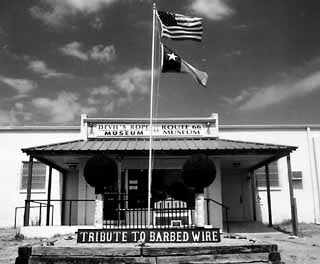Day Trips
The Devil's Rope Museum in McLean chronicles the closing of the Great American Plain with barbed wire.
By Gerald E. McLeod, Fri., Oct. 19, 2001

The Devil's Rope Museum, in the Texas Panhandle town of McLean, tells the story of one of the Old West's most maligned products. Despite its sharp reputation, barbed wire was as instrumental in taming the open prairies as windmills, six-shooters, and the Winchester repeating rifle.
Before the Civil War, fences east of the Mississippi River were made of trees that had to be cleared anyway to make way for corn fields and pastures. The homesteaders and ranchers in the West needed a cheap and easy way to cordon off large sections of land.
On the Panhandle plains, where a tree was as scarce as a bump on a pool table, fence lines stretched for miles. The XIT Ranch alone covered 10 counties and had more than 6,000 miles of imported posts and barbed wire fence by 1912. The wire rope was used to keep cattle out of the farmer's field as well as in the rancher's pasture. It was the last nail in the coffin of the great migrating herds of buffalo. Some of the original wire still divides the grasslands.
According to Harold Hagemeier, curator of the Devil's Rope Museum, Americans began experimenting with barbed wire as early as 1868. It wasn't until 1874 that a manufacturing process for a twisted wire barb between two strands of wire was invented by Joseph Glidden. The invention came just as the open grasslands of West Texas were being claimed, bought, and sold.
Glidden demonstrated his new product on 250,000 acres of range land in Potter and Randall counties called the Frying Pan Ranch. The perimeter was surrounded by more than 120 miles of barbed wire fence. Portions of the ranch were later subdivided and became the city of Amarillo.
At first, cattlemen and farmers were skeptical that the wire was strong enough to contain the massive bovines, Hagemeier says in an article he wrote for The Barbed Wire Collector Magazine. A 21-year-old wire salesman from DeKalb, Illinois, got the ball rolling for barbed wire in Texas. John "Bet-a-million" Gates received a chilly reception when he first tried to peddle his new fencing material in San Antonio.
To prove the product's worth, Gates built a wire corral in Military Plaza and drove a herd of restless cattle into the pen. It didn't take the cattle long to discover the futility and pain of challenging the fence. When the dust cleared the ranchers were equally persuaded, and Gates became a millionaire.
Hagemeier, who also wrote the Barbed Wire Identification Encyclopedia, says there were only about 450 patents for barbed wire, but more than 2,000 different varieties and designs. More than a century after the wire fence began sectioning off parcels of the Great American Prairie, modern-day collectors seek out samples of the wire like art connoisseurs after rare sculptures.
Within the McLean museum, several collections showcase the unusual designs from a flat ribbon with diamond-shaped barbs welded at regular intervals to a single strand of wire with short pieces of wire wrapped around it to form a barb. The Frank Smith Collection is the largest in the museum, with more than 660 different examples of barbed wire designs.
The museum in McLean, off I-40, 75 miles east of Amarillo, opened in 1991 to give Texas barbed-wire collectors a place to show their collections, says Davie Gipson, the manager of the museum. Many of the displays that go in circles or in neat rows are as unusual as the pieces of wire all identified and labeled.
Along with examples of the wire, the museum has fence-making machines that show how the wire was twisted and rolled. A barbed-wire-making machine in the museum is still operational and local rancher, Delbert Trew, demonstrates its use on occasion, when he's not making sculptures of hats, boots, jackrabbits, or armadillos out of barbed wire.
One wall is dedicated to the use of barbed wire in the military. "In World War I every soldier was issued wire cutters," Gipson says. The display chronicles the history of the wire in war from the early 1900s to the Gulf War in the 1990s.
Not only is the museum the largest collection of barbed wire in the world, but it is also the largest collection of ranching implements and related materials. It is amazing to see all of the different variations of tools used in agriculture and the innovation used to make hard work a little easier.
The history of ranching and the settling of the Texas Panhandle are captured in the rows and rows of displays. A wooden panel of cattle brands stretches down two aisles. Drawings, photographs, and objects from everyday life make history come alive in the museum.
In a large corner of the museum, the Old Route 66 Association of Texas displays memorabilia from the days when travelers passed within a block of the museum headed toward Chicago or Los Angeles. Small in comparison to the barbed wire and ranching collections, the Route 66 showroom displays hundreds of items from the useful to the kitsch. A recreated diner is a perfect photo opportunity in front of the mannequins of a waitress and a cook.
The Devil's Rope Museum is on the east side of downtown McLean at 100 Kingsley. The museum is open Tuesday through Saturday, 10am-4pm. Supported by barbed-wire collectors around the U.S., Canada, and Australia and a small gift shop, admission to the museum is free. For more information, call 806/779-2225 or www.barbwiremuseum.com. A few blocks west of the museum is a refurbished Phillips 66 gas station that looks like it could have opened the day before.
541st in a series. Day Trips, Vol. 2, a book of Day Trips 101-200, is available for $8.95, plus $3.05 for shipping, handling, and tax. Mail to: Day Trips, PO Box 33284, South Austin, TX 78704.








